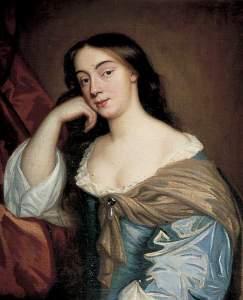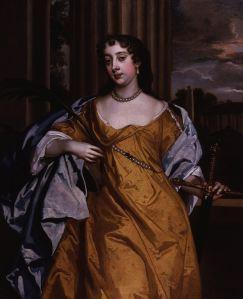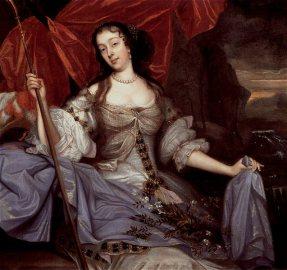Lady Castlemaine…[went] away…upon some slighting words of the king, so that…the king, the next morning, under pretence of going a hunting, went to see her and make friends…After which she came back to court, and commands the king as much as ever, and hath and doth what she will. – The Diary of Samuel Pepys, July 22nd, 1663
Though the majority of whores have always been born in the working class, when disposition, circumstance and necessity converge to make harlotry the most attractive choice, women of noble birth are just as quick to make it as their humbler sisters. And when looks and personality converge to give her a higher-than-ordinary degree of sexual power over men, a noble-born courtesan is no more likely to be sparing in the use of that power than any other.
 Barbara Villiers was born in Westminster on November 17th, 1640*, the only child of William Villiers, the 2nd Viscount Grandison, and his wife Mary (heiress of the 1st Viscount Bayning). She would have been a very wealthy little girl after her father’s death in battle** had it not been for the fact that he had given his entire fortune to the Cavalier war effort; Mary and her daughter were left in poverty, and she was forced by necessity to marry her husband’s cousin Charles (the 2nd Earl of Anglesey) in order to have any income at all. The Commonwealth was not a good time for the Villiers family; though like many others they had officially espoused loyalty to Cromwell, they secretly supported the claim of the exiled Charles II and lived under a cloud of suspicion due to their active participation on his father’s side during the Civil War. Barbara was raised in the country by relatives, but by 15 she had blossomed into an exceptionally beautiful young woman (tall and voluptuous, with chestnut hair and eyes of so dark a blue they looked black); her mother brought her to London with the idea of marrying her to a wealthy family despite her lack of a dowry. Within a year the intelligent, independent Barbara had become the mistress of Philip Stanhope, 2nd Earl of Chesterfield, and on April 14th, 1659 she married a young lawyer named Roger Palmer, heir to a large fortune, over his family’s vociferous objections (including, but not limited to, the fact that he was Catholic and she Anglican). Though on paper they never divorced, in reality they separated in 1662.
Barbara Villiers was born in Westminster on November 17th, 1640*, the only child of William Villiers, the 2nd Viscount Grandison, and his wife Mary (heiress of the 1st Viscount Bayning). She would have been a very wealthy little girl after her father’s death in battle** had it not been for the fact that he had given his entire fortune to the Cavalier war effort; Mary and her daughter were left in poverty, and she was forced by necessity to marry her husband’s cousin Charles (the 2nd Earl of Anglesey) in order to have any income at all. The Commonwealth was not a good time for the Villiers family; though like many others they had officially espoused loyalty to Cromwell, they secretly supported the claim of the exiled Charles II and lived under a cloud of suspicion due to their active participation on his father’s side during the Civil War. Barbara was raised in the country by relatives, but by 15 she had blossomed into an exceptionally beautiful young woman (tall and voluptuous, with chestnut hair and eyes of so dark a blue they looked black); her mother brought her to London with the idea of marrying her to a wealthy family despite her lack of a dowry. Within a year the intelligent, independent Barbara had become the mistress of Philip Stanhope, 2nd Earl of Chesterfield, and on April 14th, 1659 she married a young lawyer named Roger Palmer, heir to a large fortune, over his family’s vociferous objections (including, but not limited to, the fact that he was Catholic and she Anglican). Though on paper they never divorced, in reality they separated in 1662.
The reason for that separation was, as you may have already guessed, her infidelity. In the autumn after their marriage, the royalists dispatched Barbara to The Hague with letters and money for the King; since she was only 18 at the time, it was felt she would arouse less suspicion (and her person was much less likely to be searched in any case). Before she returned to England, she had already become Charles’ lover; at first they were relatively discreet about it, but by the Restoration of the monarchy in April of 1661 it was secret to virtually nobody. When her daughter Anne was born in February of 1661 the King, her husband and Chesterfield all claimed the child as theirs, and when Palmer was created Baron Limerick and Earl of Castlemaine later that year it was whispered that the titles were payment for his wife’s services; unlike the husbands of Lillie Langtry and Alice Keppel, however, Palmer was not at all sanguine about the arrangement. When Barbara’s second child, Charles, was born in June of 1662, Palmer had him baptized Catholic; Barbara later had him re-baptized Anglican in a ceremony attended by His Majesty, who publicly proclaimed the child his. It was the last straw for Palmer, who never saw his wife again; though he had a long (but stormy) political career until his death in 1705, he was deeply humiliated by his reputation as “Europe’s best-known cuckold”.
 When the new Queen, Catherine of Braganza, arrived at court from her honeymoon soon after baby Charles’ birth, she discovered her new husband’s mistress already in control; the fact was hammered home when the King demanded she accept Barbara’s appointment as a Lady of the Bedchamber, an official position which would give both an income and rooms at the Palace. The Queen had already been told about Barbara by friends, so naturally she refused; Charles became furious and sent the ladies she had brought with her home to Portugal. The King’s chief advisor, Edward Hyde, 1st Earl of Clarendon, hated Barbara with a passion, but gritted his teeth and advised the Queen to relent for her own good; Barbara repaid this reluctantly-given help by plotting with his political enemies to bring about his downfall in August of 1667.
When the new Queen, Catherine of Braganza, arrived at court from her honeymoon soon after baby Charles’ birth, she discovered her new husband’s mistress already in control; the fact was hammered home when the King demanded she accept Barbara’s appointment as a Lady of the Bedchamber, an official position which would give both an income and rooms at the Palace. The Queen had already been told about Barbara by friends, so naturally she refused; Charles became furious and sent the ladies she had brought with her home to Portugal. The King’s chief advisor, Edward Hyde, 1st Earl of Clarendon, hated Barbara with a passion, but gritted his teeth and advised the Queen to relent for her own good; Barbara repaid this reluctantly-given help by plotting with his political enemies to bring about his downfall in August of 1667.
These are only a few examples of Barbara’s extraordinary selfishness and viciousness. Though she was witty and charismatic and could be generous and even kind when it suited her, she had a terrible temper and was merciless to those she perceived as enemies; she was described by George Reresby as “the finest Woman of her age“, but by John Evelyn as the “curse of our nation“. She had a powerful hold on King Charles, partly due to her looks and partly to her legendary sexual prowess; her influence was so great that after one of their many arguments she could always get him to come crawling to her, and on more than one occasion she actually got him to apologize in front of witnesses. He showered her with gifts, and not long after his coronation gave her a payment of £30,000 (about £2.5 million today); he also granted her an annual pension of £4700 (£400,000) from the Post Office, and allowed her to take additional money out of his own purse whenever she liked. After her sudden conversion to Catholicism in December of 1663, she also made extra money by charging French and Spanish diplomats for using her persuasive powers to sway the Anglican King in their favor.
 Barbara bore King Charles three more children: Henry (1663), Charlotte (1664) and George (1665); all of her children were eventually granted titles, even the youngest (also called Barbara), who was born in 1672 and was probably the daughter of John Churchill. Neither Barbara nor King Charles had ever been faithful to each other, but while the King did not care she was quite jealous because it meant her income. The concern was not an invalid one; since April of 1668 the King’s favorite had been the younger and far more even-tempered Nell Gwyn. In June of 1670 he gave Barbara one final set of generous gifts as a kind of severance package: she was given Nonsuch Palace, built by Henry VIII, and the titles Baroness Nonsuch, Countess of Castlemaine and Duchess of Cleveland (the latter was a true peerage, made with a condition allowing her to pass the title to her son Charles). She was still nominally the official mistress until 1673, when the Test Act banned Catholics from holding office; she thus lost her position as Lady of the Bedchamber to Louise de Kéroualle, Nell Gwyn’s chief rival. In 1676 she moved to Paris with her four younger children, but returned to England in 1680 and enjoyed a friendly relationship with the King until his death in February of 1685. By this time she had developed a terrible gambling habit, and in 1682 had Nonsuch Palace entirely dismantled so she could sell off its expensive materials to pay her debts. In her later years she became involved with a series of unscrupulous fortune-hunters; after Roger Palmer’s death in 1705 she actually married one of these, though it was later annulled when she discovered he already had a wife. In 1709 she developed what was then called dropsy, a condition which caused her to become so edematous that she died of congestive heart failure on October 9th. It is clear that Barbara, like so many other courtesans, had been totally unable to recognize that her sex appeal had deserted her, and adjust her expectations, lifestyle and expenditures so as to live out her declining years in comfort and some small measure of dignity. But then, dignity was never something that Barbara was very good at, even when she still had her youth and looks.
Barbara bore King Charles three more children: Henry (1663), Charlotte (1664) and George (1665); all of her children were eventually granted titles, even the youngest (also called Barbara), who was born in 1672 and was probably the daughter of John Churchill. Neither Barbara nor King Charles had ever been faithful to each other, but while the King did not care she was quite jealous because it meant her income. The concern was not an invalid one; since April of 1668 the King’s favorite had been the younger and far more even-tempered Nell Gwyn. In June of 1670 he gave Barbara one final set of generous gifts as a kind of severance package: she was given Nonsuch Palace, built by Henry VIII, and the titles Baroness Nonsuch, Countess of Castlemaine and Duchess of Cleveland (the latter was a true peerage, made with a condition allowing her to pass the title to her son Charles). She was still nominally the official mistress until 1673, when the Test Act banned Catholics from holding office; she thus lost her position as Lady of the Bedchamber to Louise de Kéroualle, Nell Gwyn’s chief rival. In 1676 she moved to Paris with her four younger children, but returned to England in 1680 and enjoyed a friendly relationship with the King until his death in February of 1685. By this time she had developed a terrible gambling habit, and in 1682 had Nonsuch Palace entirely dismantled so she could sell off its expensive materials to pay her debts. In her later years she became involved with a series of unscrupulous fortune-hunters; after Roger Palmer’s death in 1705 she actually married one of these, though it was later annulled when she discovered he already had a wife. In 1709 she developed what was then called dropsy, a condition which caused her to become so edematous that she died of congestive heart failure on October 9th. It is clear that Barbara, like so many other courtesans, had been totally unable to recognize that her sex appeal had deserted her, and adjust her expectations, lifestyle and expenditures so as to live out her declining years in comfort and some small measure of dignity. But then, dignity was never something that Barbara was very good at, even when she still had her youth and looks.
*Because Catholic realms (including France and Ireland) had already converted to the Gregorian calendar at this time but the United Kingdom had not, it is not unusual to see her birthday expressed in the new style as November 27th, and some sources record the year as 1641.
**There is considerable disagreement about which Civil War battle claimed Villiers’ life; Wikipedia says Newbury (September 20th, 1643); other sources say Bristol (July 26th, 1643); and Bishop Burnet’s contemporary history says Edgehill (October 23rd, 1642).
